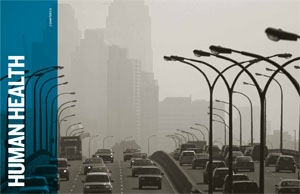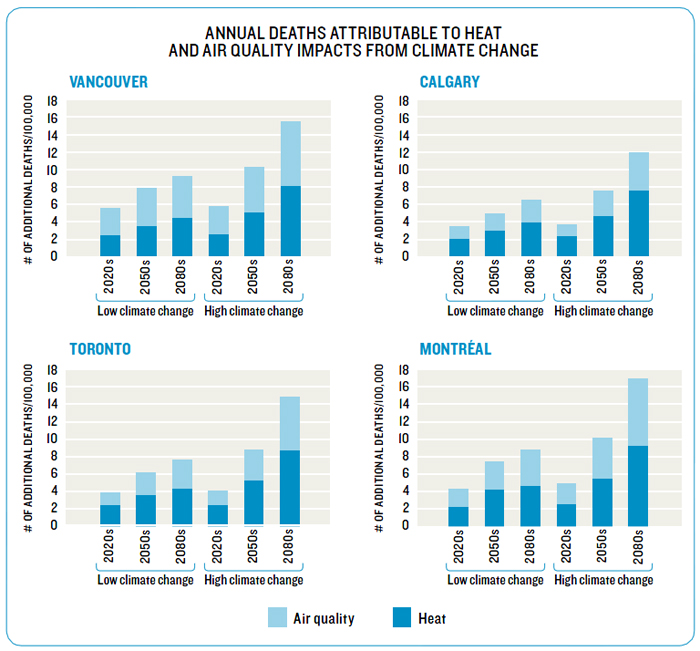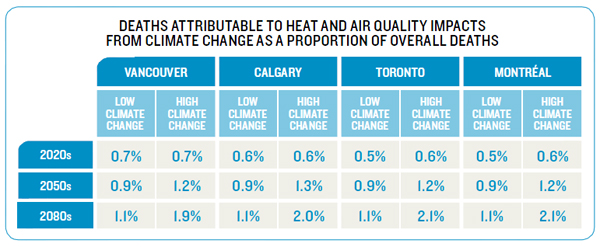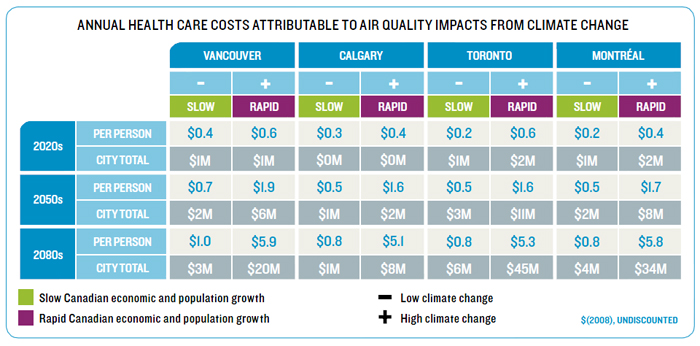Paying the Price – Human Health
Warmer summers and worsened air quality from climate change will have consequences for the health of Canadians. By mid-century, these impacts could be responsible for roughly 1% of deaths in Canada.Weather and climate directly and indirectly affect our health. Illnesses, injuries, and deaths observed during and after events such as the 1998 ice storm in eastern Canada, the European heat wave in 2003, and recent flooding in Pakistan are all reminders of this reality.
A changing climate has the potential to affect our health status through several pathways. For example, high temperatures exacerbate heat stroke risk and combined with changes in other weather indicators like air moisture, also alter air quality, affecting existing cardiovascular (e.g., heart conditions) and respiratory (e.g., asthma) illness. In some locations, heat spells, intense rains, and violent storms are likely to become more common compared with today, with the potential to increase the number of injuries, deaths, and evacuations. A drop in extreme cold days could reduce illnesses and deaths in winter. For some populations, greater risk of exposure to infectious diseases and diseases transmitted through water and food is also expected.
changing climate has the potential to affect our health status through several pathways. For example, high temperatures exacerbate heat stroke risk and combined with changes in other weather indicators like air moisture, also alter air quality, affecting existing cardiovascular (e.g., heart conditions) and respiratory (e.g., asthma) illness. In some locations, heat spells, intense rains, and violent storms are likely to become more common compared with today, with the potential to increase the number of injuries, deaths, and evacuations. A drop in extreme cold days could reduce illnesses and deaths in winter. For some populations, greater risk of exposure to infectious diseases and diseases transmitted through water and food is also expected.
HEALTH IMPACTS DUE TO CLIMATE CHANGE
- Climate change results in additional deaths from heat and air pollution across the four cities on the order of three to six deaths per 100,000 people per year in the 2020s, with impacts worsening in future decades.
- According to our analysis, by the 2080s, deaths related to higher temperatures and poorer air quality attributable to climate change could account for 1% to 2% of the total deaths within the cities examined.
- In a changing climate, deteriorating air quality will lead to an additional four to seven hospital visits per 100,000 people per year by the 2050s.
- Poorer air quality will also increase the number of days people present with respiratory problems resulting in a roughly three-fold increase with high climate change and a roughly two-fold increase with low climate change, between the 2020s and 2080s.
ECONOMIC IMPACTS
-
The costs of premature death risks from climate change calculated based on the VSL are in the order of billions of dollars per year for each city, and they grow over time.
-
In present value terms, the costs for each city between now and the end of the century will be in the tens of billions of dollars.
-
The economic burden on the public health care system from illness in a changing climate amounts to millions of dollars per year for each city and grows over time. In a high climate change scenario, this economic burden, on average, grows from 40 cents per person per year in the 2020s to over $5 per person per year in the 2080s.
-
In present value terms, the added costs to the health care system from cases of rising illness in the four cities between now and the end of the century totals hundreds of millions of dollars.
ADAPTATION STRATEGIES
Several strategies exist to reduce the adverse impacts of climate change on our health.Examples of adaptive measures pertaining to heat and air quality impacts of climate change include public education (e.g., reducing physical activity at times when temperatures or air pollution are particularly high), reducing the urban heat-island effect, putting in place early warning systems, opening cooling centres during heat waves, and treating illnesses as they arise. Air conditioning is among the most effective ways to deal with health issues arising from heat, and public health agencies promote this coping strategy among vulnerable populations. However, increasing electricity production to meet the demand created by air conditioners can worsen local air quality and add to greenhouse gas emissions (depending on the electricity source), creating further health risks. Strategies often include a range of measures.
Reducing the urban heat -island effect through green roofs: The heat-island effect can make cities several degrees warmer than the rural areas that surround them. This is by virtue of heat-absorbing building and pavement materials and widespread processes that release waste heat that are concentrated in cities (e.g., automobiles). Strategies to enhance evapotranspiration, reduce the heat flow through walls and roofs, and make cities reflect more sunlight, for example through lightening the colour of surfaces and increasing vegetation, can reduce air temperatures.
Improving air quality by installing controls to reduce ozone-forming emissions: The concentration of cars, industry, and households in urban areas contributes to local air pollution and ozone formation. Some air pollutant emissions like nitrogen oxides (NOx) and volatile organic compounds (VOCs) are considered to be ozone “pre-cursors” in the sense that these pollutants can cause ozone to form in the lower atmosphere. Strategies that reduce ozone-forming air pollutant emissions could help to offset the air quality impacts of climate change.




























